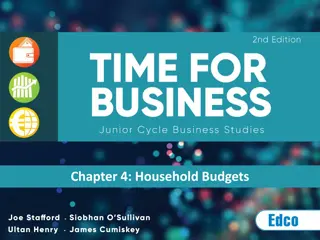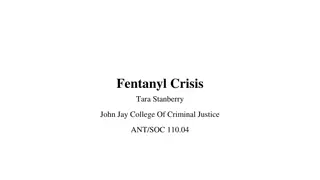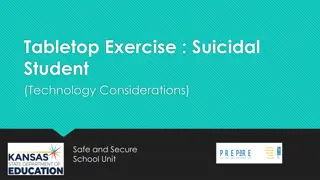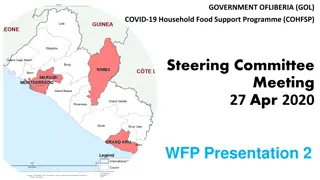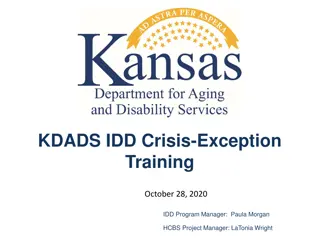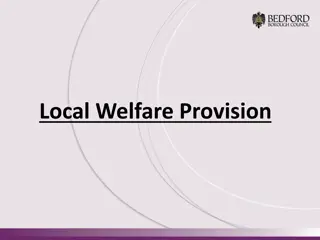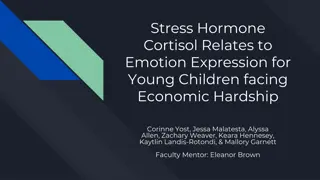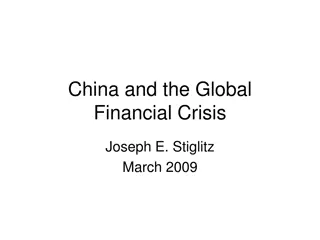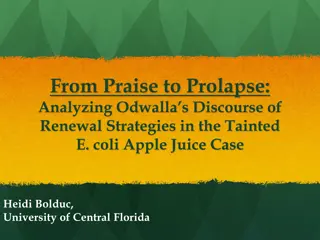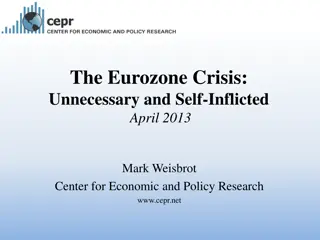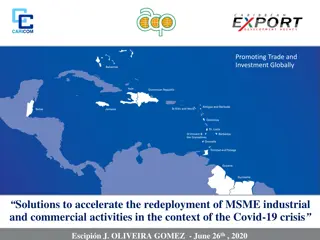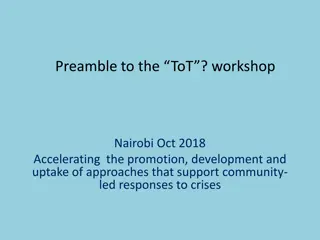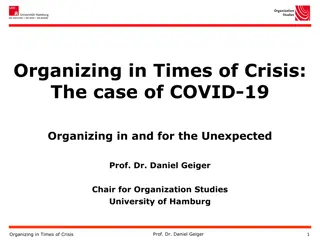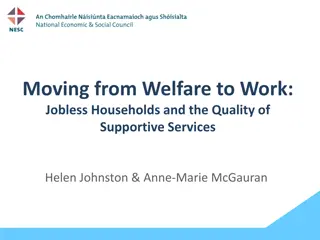Exploring Household Responses to Hardship in Times of Crisis
Investigating household responses to hardship in post-crisis Europe with a focus on agency, implications for resilience research, and qualitative methods. The seminar aims to understand how households navigate challenges and the contextual factors influencing their strategies.
Download Presentation

Please find below an Image/Link to download the presentation.
The content on the website is provided AS IS for your information and personal use only. It may not be sold, licensed, or shared on other websites without obtaining consent from the author. Download presentation by click this link. If you encounter any issues during the download, it is possible that the publisher has removed the file from their server.
E N D
Presentation Transcript
Household responses to hardship post Household responses to hardship post Crisis Crisis in Europe in Europe & & Reflections Reflections on Resilience on Resilience Hulya Dagdeviren & Matthew Donoghue Conceptualising and applying resilience in a social policy context Sheffield Hallam University 8 February 2017
Previous work: critical assessment of the resilience approach Previous work: critical assessment of the resilience approach Dagdeviren, Donoghue, Dagdeviren, Donoghue, Promberger Promberger2016, 2016, Jou Jou. Social Pol, 45 (1) . Social Pol, 45 (1) The Resilience Concept The Resilience Concept: Bouncing back or forward beating the odds View: View: Poor people are not passive victims. They have agency to control their circumstances BUT BUT resilience is not an unproblematic concept 1. How do we distinguish agency from structural influences? 2. How do we distinguish resilient from non-resilient HHs ? 3. How do we explain intermittence and continuity in resilience? 4. How to reconcile (+) resilience with its potentially detrimental consequences? 5. Ideological use of the term to justify regressive changes in the society? Resilience needs to be considered in the context of social conditions which are shaped by Resilience needs to be considered in the context of social conditions which are shaped by structure and path dependency structure and path dependency (i.e. individual & social history)
Outline of Seminar Aim Aim Investigate households (HH) responses to hardship in times of crises Explore nature of agency in these responses Assess implications for resilience research Focus Focus: : Post crisis, Europe Coverage Coverage: : low and middle income households Method Method: : qualitative, semi-structured interviews & visual ethnography
Conceptualisation Context of studies Context of studies (Wallace 2002, Datta et al 2007): Restructuring, crisis, transition, informal econ, LDC HH strategies (*) Expenditure reducing vs income generating (Elder 1974) Work based, network based and agency based (Edin & Lein 1997) Emotion (distancing / fantasizing) vs. problem-focused coping (Lazarus & Folkman 1984) Market, non-market (e.g. reciprocity) & alternative (black econ) (Smith & Stenning, 2006) Asset / resource based (Mingione 1987) Ex-ante vs. ex-post (Dearcon 2002, Skoufias 2003, Bene et al 2012) Livelihood strategies, risk pooling (Ellis 2000, Park ?) Active, social network based and passive strategies (Lokshin & Yemtsov 2004) (*) Critique: Strategy implies rational choice , adapted from military & corporate contexts (Crow, 1989).
Theoretical Theoretical frameworks frameworks 1) 1) Structure and agency Structure and agency debate with two main considerations a) the extent to which hardship is produced by forces above and beyond individuals (i.e. structure e.g. class divisions, econ & political power impacting living conditions) and the extent to which that structure determine (enable or limit) peoples responses to hardship b) The extent to which individual action (choices, decisions, effort, struggles, etc.) can counteract with hardship whether caused by structure or own action Agency 2) Life 2) Life course approach course approach: : Rejects extreme structuralism. Analysis emphasizes a) Timing of lives (e.g. post WW2, the neo-liberal era) b) Life Stage (e.g. age) c) Links in Life (relationships & interdependencies) The approach is useful and provides a bridge between agency and structure but may be limited in studying emergent responses (Elder 1981, Hareven 1977) 3) Resilience approach: 3) Resilience approach: Approach is in its infancy. Risk of being agent-centric.
FRAMEWORK FOR ANALYSIS (1) Initial State matters for Resilience (e.g. socio-econ status, presence of safety nets) Need to distinguish efforts & actions to counteract shocks from their consequences Type of Response to Hardship 1. Efforts to reduce cost of living 2. Efforts to protect incomes 3. Efforts draw on individual, group, social/public assets and resources Consequences for HHs & Society to explore nature agency 1. Positive 2. Negative 3. Mixed Is this an individual, group/collective or wider social response? Is the response aim short-term coping or long term change?
: re. response & agency (*) FRAMEWORK FOR ANALYSIS (2): re. 1) Absorptive responses /agency Efforts focus on coping in the short term burden bearing rather than structure shaping agency mostly perverse impact on well being, reflecting very limited choice 2) Adaptive responses / agency Efforts involve a continuum from coping to adaptation, from short to mid/longer term Responses fitting into rather than shaping structure consequences are case specific (+/-/mixed) without radically positive outcomes 3) Transformative responses / agency Responses with radically different outcomes that go beyond adaptation & reshape HH or social conditions. Outcomes could be (+/-) Strong agency and /or public /private support systems. (*) Obrist 2010, B n , et al. 2015, Keck & Sakdapolrak 2013
Method Method 1. Part of RESCUE 1. Part of RESCUE, a project funded by the EU-FP7 programme: Socio-Economic Patterns of Resilience in Europe: Germany, Finland, Poland, Turkey, Greece, Ireland, Portugal, Spain, UK 2. 2. Qualitative Analysis Qualitative Analysis Standard semi-structured interviews with 24 HHs & 8 KIs in each country Further interviews with visual material (photographs) of 16 HH participants HH who were in hardship at the time of interviews
THE SAMPLE AND DATA Single HH wo/d Couples wo/d HH Size 3-4 Location w/d w/d 1-2 5+ GR 2 towns in Athens 10 2 0 12 10 8 6 Madrid & La Mancha 5 1 0 18 3 14 7 ES 2 Towns in Midlands 3 5 4 12 8 8 8 IE E. London, Cornwall, Pembrokeshire 10 5 1 8 14 8 2 UK 2 towns in Lisbon & Santar m 4 5 3 12 7 9 8 PT B dzin & Silesia, Racib rz 1 5 4 14 8 9 7 PL 2 towns in Lapland 4 4 2 14 8 9 7 FI Saxony & Leipzig in Germany 8 6 6 4 18 4 2 DE 2 towns in Ist & Ankara 5 1 4 14 6 6 12 TK w/d: with dependents wo/d: without dependents
Efforts to reduce cost of living 1) Going without 1) Going without (i.e. cuts in the quantity of consumption) Essential: energy (early bedtime, illegal connections); medical expenses; food. There is days I wouldn t eat at all...I give it to the kids and to him. (IE, UH7, Dagg & Gray 2015). Non-essential: holidays, treats for children, smoking, internet, phone bills, going out etc. I don t go to the hairdresser s or to bars I don t know what else to cut back. (ESP, RH1, Arnal, et al 2015) 2 2) Shopping practices ) Shopping practices to reduce cost w/o lowering consumption: bargain hunting, 2ndhand stores 3 3) Substituting ) Substituting purchased goods/services with self-provision 4 4) ) Payments & Planning Payments & Planning: : prioritising rents & bills, selective defaults, food planning I live with a pencil in hand. I always plan menu for the whole week, usually on Sundays. (PL, UH10, Wodz, et al 2015) 5) 5) Social economies Social economies of exchange things for others. In this, kinship, charities & churches play a considerable role of exchange: solidarity and reciprocity involving sharing, gift giving, doing
Agency in efforts to reduce cost of living Lowering Consumption Q (-): Mainly Absorptive, (*) Bargain hunting, use of discount stores, timing & place of shopping: case specific (+/-): Mainly Absorptive, Use of recycled goods: (+/-) Mainly Absorptive Self provision (DIY, foraging, etc) (+/-) Mainly Absorptive Planning & prioritising (+/-) Mainly Absorptive, Use of social networks and charity (+/-) Mainly Absorptive (*) could be Adaptive if permanent
Efforts to protect / stabilise incomes Accept low grade, low quality, insecure jobs Cash-in hand, sporadic informal jobs. More often, this was employers way to avoid tax & social security obligations In Portugal, Carla went from being an ophthalmology technician to work as a cab driver (Capucha et al 2015). Vivi, a sound engineer in Greece, started working as an intern hairdresser and survived on informal hairdressing jobs (Kampouri et al 2015). Use of unreported work Further education / training, often at own cost, to improve conditions of employment. Kimberley in Pembrokeshire and Simon in E. London had degrees in legal studies but the former was applying for any job, often unrelated to her qualifications and the latter was working as security personnel on zero hours contract. Migration
Efforts to protect / stabilise incomes 1. Lower standards re. acceptable jobs (-) absorptive or adaptive agency 2. (Re)training (+/-): potentially transformative agency 3. Winding down business (-) Adaptive agency 4. Unreported work: (+) individually, (-) socially. Absorptive / Adaptive agency 5. Migration (+/-): potentially transformative agency Complex interactions with structural forces depending on how wide spread these responses are and whether counteractive policies are applied
3. Use of assets & resources 1. Housing Remaining / returning to family home (-); co-habitation (-/+) Adaptive Migrating to rural areas for cheap housing (+/-) Adaptive Efforts to qualify for social housing (+) transformative / adaptive 2. Savings: most had no savings, very few had small savings (-) Absorptive 3. Use of debt is a big issue in Ireland, UK, Greece, Turkey. This is not for accumulation of wealth but maintaining basic expenditure (-) absorptive/ adaptive Sometimes you just spend on the card and the bank keep charging you because you just say to yourself, say listen we ve got to feed these kids [Mary, 45 yrs, single parent, 3 kids, E. London] 4. Public resources (e.g. for leisure activities, foraging) (+) adaptive like it's been a playground, this wood, it's been an adventure place... well we can't go to XX centre, I've no money, [...], so, when it's sad we made it fun" (IE, RH2).
Conclusions 1. Most HH responses was characterized with absorptive & adaptive responses, involving burden bearing & fitting into rather than shaping the structure for better. 2. The most widely used response was expenditure cutting (mainly absorptive). Sometimes it had severe results (e.g. cutting down on food to the point of hunger), signifying limited choices. 3. Income related responses were adaptive but limited in range because of austerity 4. In few cases, the impact of actions with potentially transformative influence on the lives of people (education, re-training) was muted because of the context (i.e. crisis & downturn). 5. Asset/resource related actions potentially contained more transformative elements. This highlights the importance of public resources and support systems for resilience of individuals in the absence of private wealth. 6. Open access public resources such as parks, libraries, play grounds, leisure centers played an important role in lifting participants quality of life in crisis.
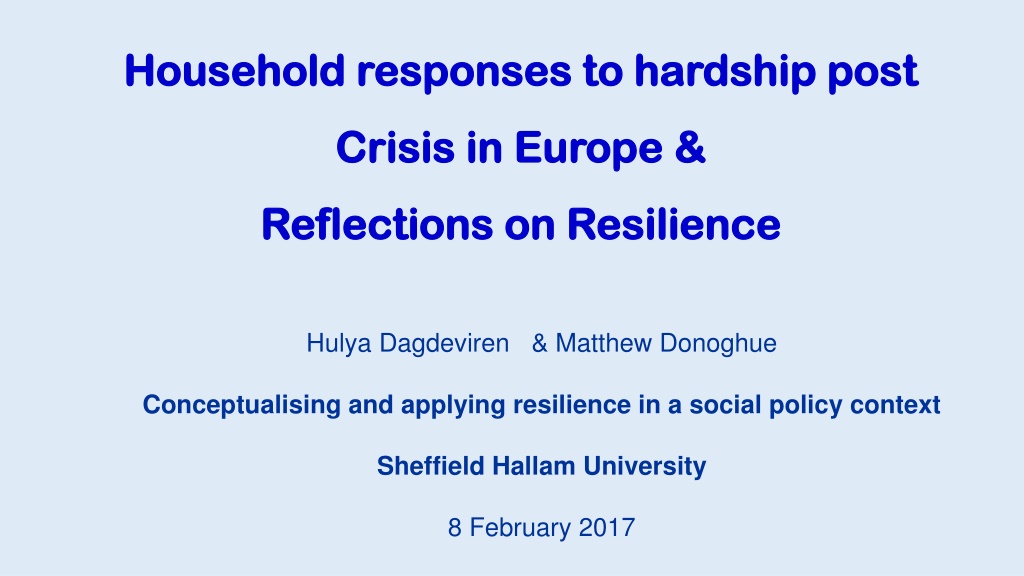

![Financial hardship and the economic burden of health [cancer] care](/thumb/779/financial-hardship-and-the-economic-burden-of-health-cancer-care.jpg)


